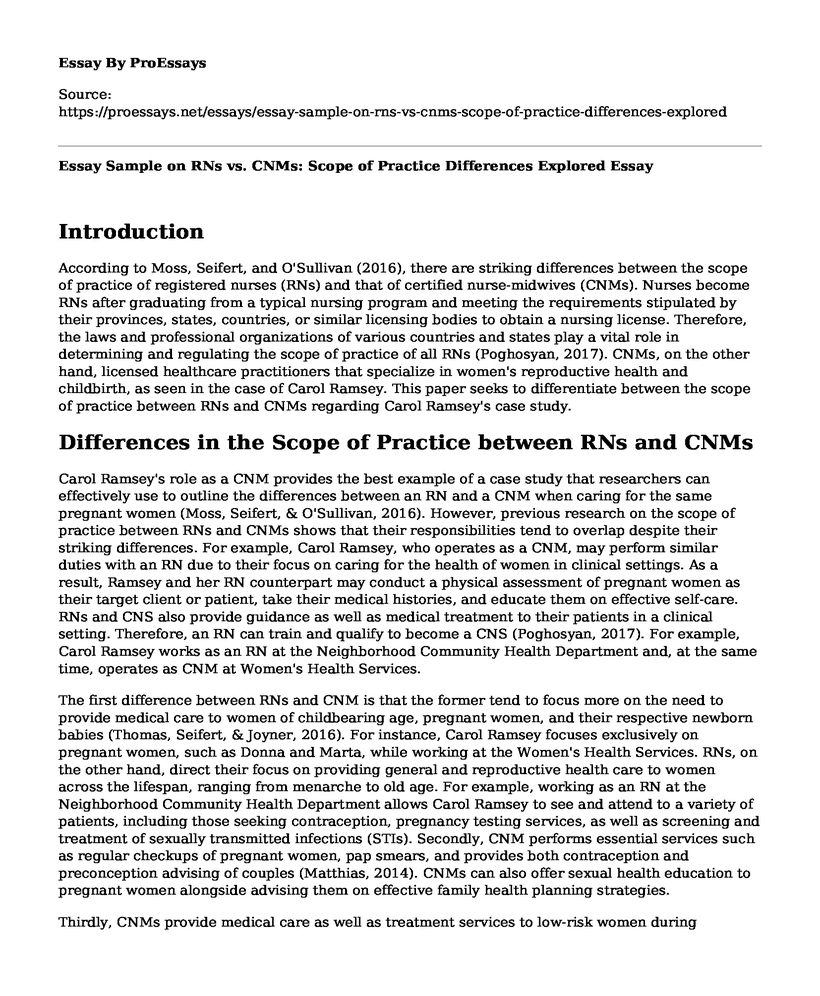Introduction
According to Moss, Seifert, and O'Sullivan (2016), there are striking differences between the scope of practice of registered nurses (RNs) and that of certified nurse-midwives (CNMs). Nurses become RNs after graduating from a typical nursing program and meeting the requirements stipulated by their provinces, states, countries, or similar licensing bodies to obtain a nursing license. Therefore, the laws and professional organizations of various countries and states play a vital role in determining and regulating the scope of practice of all RNs (Poghosyan, 2017). CNMs, on the other hand, licensed healthcare practitioners that specialize in women's reproductive health and childbirth, as seen in the case of Carol Ramsey. This paper seeks to differentiate between the scope of practice between RNs and CNMs regarding Carol Ramsey's case study.
Differences in the Scope of Practice between RNs and CNMs
Carol Ramsey's role as a CNM provides the best example of a case study that researchers can effectively use to outline the differences between an RN and a CNM when caring for the same pregnant women (Moss, Seifert, & O'Sullivan, 2016). However, previous research on the scope of practice between RNs and CNMs shows that their responsibilities tend to overlap despite their striking differences. For example, Carol Ramsey, who operates as a CNM, may perform similar duties with an RN due to their focus on caring for the health of women in clinical settings. As a result, Ramsey and her RN counterpart may conduct a physical assessment of pregnant women as their target client or patient, take their medical histories, and educate them on effective self-care. RNs and CNS also provide guidance as well as medical treatment to their patients in a clinical setting. Therefore, an RN can train and qualify to become a CNS (Poghosyan, 2017). For example, Carol Ramsey works as an RN at the Neighborhood Community Health Department and, at the same time, operates as CNM at Women's Health Services.
The first difference between RNs and CNM is that the former tend to focus more on the need to provide medical care to women of childbearing age, pregnant women, and their respective newborn babies (Thomas, Seifert, & Joyner, 2016). For instance, Carol Ramsey focuses exclusively on pregnant women, such as Donna and Marta, while working at the Women's Health Services. RNs, on the other hand, direct their focus on providing general and reproductive health care to women across the lifespan, ranging from menarche to old age. For example, working as an RN at the Neighborhood Community Health Department allows Carol Ramsey to see and attend to a variety of patients, including those seeking contraception, pregnancy testing services, as well as screening and treatment of sexually transmitted infections (STIs). Secondly, CNM performs essential services such as regular checkups of pregnant women, pap smears, and provides both contraception and preconception advising of couples (Matthias, 2014). CNMs can also offer sexual health education to pregnant women alongside advising them on effective family health planning strategies.
Thirdly, CNMs provide medical care as well as treatment services to low-risk women during pregnancy, labor, and the postpartum period (Thomas, Seifert, & Joyner, 2016). For example, Carol Ramsey's role as a CNM required her to help Donna and Marta alongside other clients to effectively manage their pregnancies until delivery. Ramsey also supported the two clients during labor and took care of them after birth. RNs' scope of practice allows them to perform similar services. However, the role of RNs in such settings includes additional responsibilities that have no direct relationship with sexual and reproductive health. For instance, RNs may provide high-quality primary care of post-menopausal women, conduct screening for breast cancer and heart diseases, and offer treatment services for related conditions and infections (Matthias, 2014). Lastly, RNs tend to work closely with doctors in clinical settings and areas requiring continuous health promotion and education services as opposed to CNMs.
Conclusion
The scope of practice of between RNs and CNMs differ sharply. CNMs provide treatment and health promotional services in a clinical setting, with a particular focus on pregnant women. RNs, on the other hand, provide general services that cater to the needs of every woman regardless of her age and pregnancy status, as seen in the case of Carol Ramsey when working at the Neighborhood Community Health Department. However, professionals in these two types of occupation may deliver comparable high-quality services in a clinical setting to ensure the well-being of their patients as the target clients, as discussed in this paper.
References
Matthias, D. (2014). Making the case for differentiation of registered nurse practice: Historical perspectives meet contemporary efforts. Journal of Nursing Education and Practice, 5(4), 108-114. Retrieved from http://www.sciedu.ca/journal/index.php/jnep/article/view/6008/3851.
Moss, E., Seifert, P. C., & O'Sullivan, A. (2016). Registered Nurses as Interprofessional Collaborative Partners: Creating Value-Based Outcomes. The Online Journal of Issues in Nursing, 21(1), 11-20. Retrieved from http://ojin.nursingworld.org/MainMenuCategories/ANAMarketplace/ANAPeriodicals/OJIN/TableofContents/Vol-21-2016/No3-Sept-2016/Registered-Nurses-as-Interprofessional-Collaborative-Partners.html.
Poghosyan, L. (2017). Primary Care Nurse Practitioner Practice Characteristics. Journal of Ambulatory Care Management, 40(1), 77-86. Retrieved from https://www.ncbi.nlm.nih.gov/pmc/articles/PMC5484049/.
Thomas, J. W., Seifert, P. C., & Joyner, J. C. (2016). Registered nurses leading innovative changes. The Online Journal of Issues in Nursing, 21(3), 1-10. Retrieved from http://ojin.nursingworld.org/MainMenuCategories/ANAMarketplace/ANAPeriodicals/OJIN/TableofContents/Vol-21-2016/No3-Sept-2016/Registered-Nurses-Leading-Innovative-Changes.html.
Cite this page
Essay Sample on RNs vs. CNMs: Scope of Practice Differences Explored. (2023, Mar 29). Retrieved from https://proessays.net/essays/essay-sample-on-rns-vs-cnms-scope-of-practice-differences-explored
If you are the original author of this essay and no longer wish to have it published on the ProEssays website, please click below to request its removal:
- Position Paper on the Benefits and Risks of Statin Drugs Essay
- Intuitive Eating Essay
- Critical Thinking in Nursing Process and Plan of Care Essay
- Nutrition Reflection Paper Example
- Essay Sample on Key Issues in Pharmaceutical Industry Supply Chains
- Essay Example on Omphalocele: Abdominal Wall Defects & Pathophysiology
- Essay on Evidence-Based Practice: Communication Strategies for Engaging New Nurses







